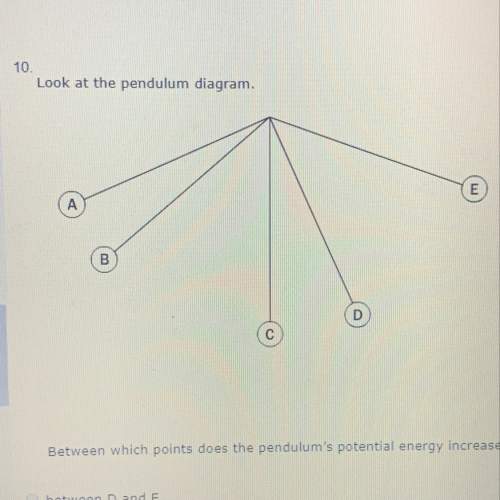
When two objects collide and stick together, what will happen to their speed, assuming momentum is conserved?
They will move at the same velocity as whichever object was fastest initially.
They will move at the same velocity of whichever object was slowest initially.
They will move more quickly.
They will move more slowly.

Answers: 3


Another question on Physics

Physics, 21.06.2019 22:30
Follow these directions and answer the questions. 1. shine a pencil-thin beam of light on a mirror perpendicular to its surface. (if you don't have a laser light as suggested in the video, you can make a narrow beam from a flashlight by making a cone from black construction paper and taping it over the face of the flashlight.) how does the light reflect? how does the relationship of incident to reflected ray relate to the reflection of water waves moving perpendicular to a barrier? 2. shine a pencil-thin beam of light on a mirror standing on a sheet of paper on the table (or floor) so that you can mark the incident ray and reflected ray. (you can support the mirror from the back by taping it to a wooden block.) 3. mark a line on the paper representing the reflective surface. (the reflective surface of a mirror is usually the back edge.) 4. draw a dashed line perpendicular to the mirror surface at a point where the incident and reflected ray meet. this perpendicular is called a normal to the surface. 5. measure the angles between the rays and the normal. the angle of incidence is the angle formed by the incident ray and the normal to the surface. the angle formed by the reflected ray and normal is called the angle of reflection (r). what is the angle of incidence? what is the angle of reflection? 6. repeat for several different angles. (see report sheet for details.) what appears to be the relationship between the angle of incidence and angle of reflection? in science 1204, what was the relationship for these two angles made by the reflection of waves in a ripple tank? 7. roll a ball bearing so that it hits a fixed, hard surface (a metal plate) at several angles (including head-on). observe the way in which the ball bearing reflects. what generalization can you make about how a ball bearing reflects from a wall? have you proved that light can only behave like a wave?
Answers: 1

Physics, 22.06.2019 03:50
Three different objects, all with different masses, are initially at rest at the bottom of a set of steps. each step is of uniform height . the mass of each object is a multiple of the base mass : object 1 has mass 4..00m , object 2 has mass 1..96m , and object 3 has mass . when the objects are at the bottom of the steps, define the total gravitational potential energy of the three-object system to be zero. if the objects are then relocated as shown, what is the new total potential energy of the system? each answer requires the numerical coefficient to an algebraic expression. each algebraic expression is given using some combination of the variables , , and , where is the acceleration due to gravity. enter only the numerical coefficient. (example: if the answer is 1..23mgd , just enter 1.23)
Answers: 3

Physics, 22.06.2019 11:00
A2.00-m long piano wire with a mass per unit length of 12.0 g/m is under a tension of 8.00 kn. what is the frequency of the fundamental mode of vibration of this wire?
Answers: 3

Physics, 23.06.2019 01:30
Sally turns on her cellular telephone to speak to her friend who is located thousands of miles away. which of the following best describes how such a telephone is able to transmit and receive information? a. the cellular telephone transmits, receives, and encodes information using only sound waves. b. the cellular telephone transmits, receives, and encodes information using only electromagnetic waves. c. the cellular telephone transmits information by electromagnetic waves to a receiver which then encodes them and produces sound. d. the cellular telephone transmits information by sound waves to a receiver which then encodes them and produces electromagnetic waves.
Answers: 2
You know the right answer?
When two objects collide and stick together, what will happen to their speed, assuming momentum is c...
Questions

Mathematics, 23.10.2019 07:00



History, 23.10.2019 07:00

English, 23.10.2019 07:00

English, 23.10.2019 07:00



Mathematics, 23.10.2019 07:00

History, 23.10.2019 07:00


Mathematics, 23.10.2019 07:00


History, 23.10.2019 07:00


Advanced Placement (AP), 23.10.2019 07:00



English, 23.10.2019 07:00




